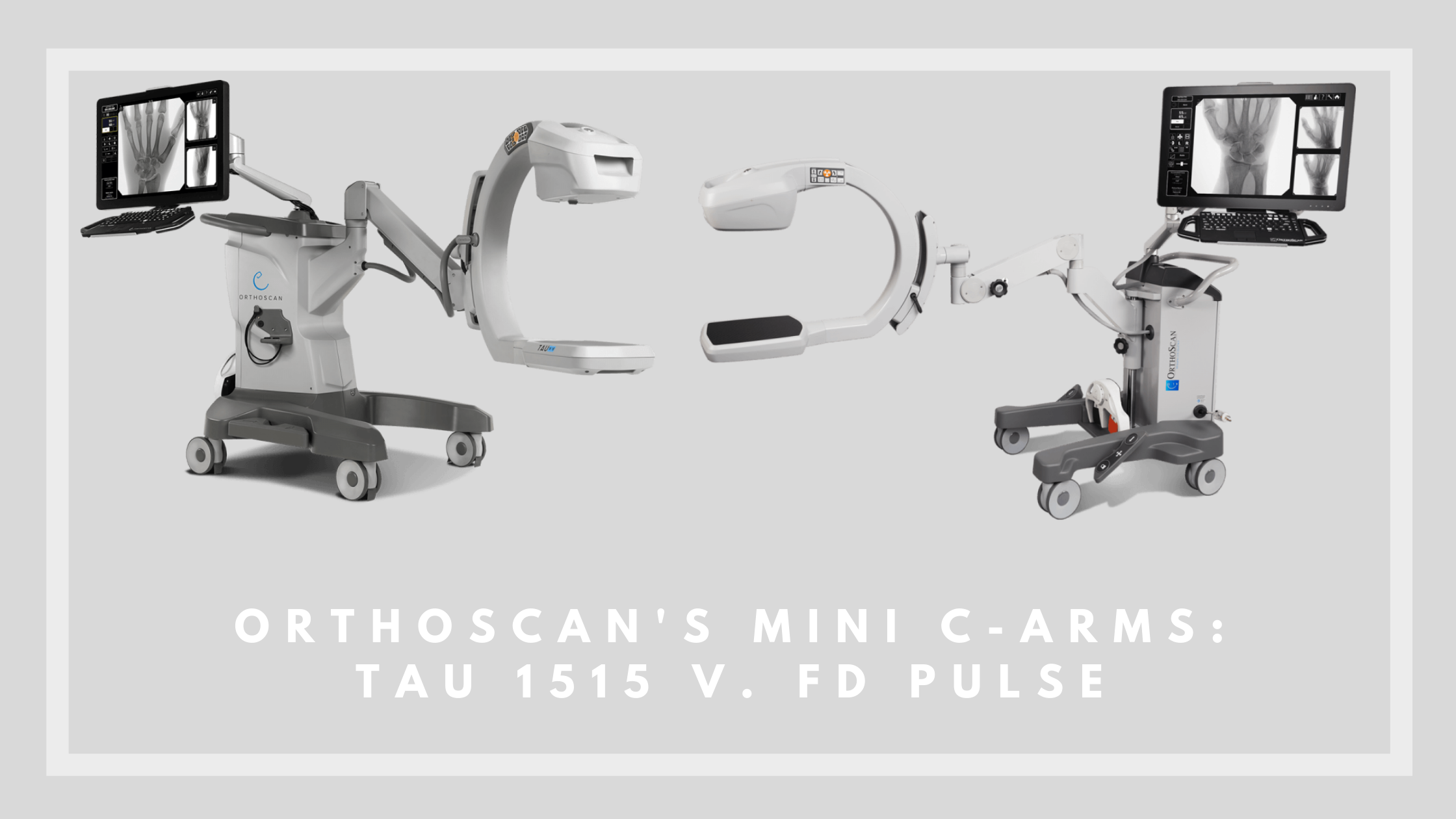Why is choosing a Mini C-Arm such a complicated process? It’s not, really, when you keep two things in mind: your needs and your budget. Focusing your needs on your specialty is especially helpful. Your budget is, well, your budget. But there are ways to get the most for what you have to spend.
Case in point, the TAU 1515 and the FD Pulse. The FD Pulse, which launched in 2014, was the first flat panel Mini C-Arm that had pulsed fluoroscopy. It was only recently discontinued. The TAU 1515, like the rest of the TAU line, was introduced in 2019 and is still in production. Let’s dive beneath the surface, take a closer look, and see which one comes out ahead!
| DETECTOR | TAU 1515 | FD PULSE |
| Type | CMOS detector | CMOS detector |
| Detector size | 15cm x 15cm | 15cm x 15cm |
| Resolution | 1.5k x 1.5k | 1.5k x 1.5k |
| Useful array | 15cm x 15cm | 15cm x 15cm |
| Pixel spacing | 99 microns | 99 microns |
| Dose rate | AKR/DAP | AKR/DAP |
When it comes to the detector, both models have the same specs. No clear winner here.
| X-RAY GENERATOR | TAU 1515 | FD PULSE |
| Focal spot | 42.5 microns | 42.5 microns |
| kV range | 40 – 78 kVp | 40 – 78 kVp |
| mA range | 0.040 – 0.160 mA | 0.040 – 0.160 mA |
| Operating Mode | Pulse/continuous | Pulse/continuous |
| Selectable pulse rate | Cont., 30, 15, 7.5 pps | Cont., 30, 15, 7.5, 2 pps |
| Pediatric Filter | ✓ |
The X-Ray generator is also nearly a wash, but not quite. If your specialty is pediatrics, you’ll want to look at the TAU 1515. If not, you may appreciate the 2 pps rate, which equates to less dosing for your patients.
| ELECTRICAL | TAU 1515 | FD PULSE |
| Sterile field controls | Bilateral | Bilateral |
| Multifunction wireless foot switch | ✓ | ✓ |
| Laser alignment | ✓ | ✓ |
| Surgical LED lights | ✓ | ✓ |
Electrical specs are clearly a tie. Either machine fits the bill here.
| DOCUMENTATION | TAU 1515 | FD PULSE |
| Wireless communication | Optional | Optional |
| DICOM 3.0 compliant | ✓ | ✓ |
| MPPS | ✓ | Capable |
| Image capacity | 26,000 | 12,000 |
| Video capacity | 14.4 min | 90 min |
| USB 2.0 Ports | ✓ | ✓ |
| Printer | ✓ | ✓ 2 options |
Documentation is critical. The 1515 has the lead in standard MPPS and image capacity. However, if your specialty requires lengthy video, the FD Pulse has the edge.
| MECHANICAL | TAU 1515 | FD PULSE |
| Weight | 475lb | 400lb |
| Height | 48″ | 44.5′ |
| Footprint (W x L) | 29″ x 33″ | 28″ x 33″ |
Things are pretty close here. The FD Pulse is lighter, shorter, and has a slightly smaller footprint.
| MONITOR | TAU 1515 | FD PULSE |
| Size | 24″ | 24″ |
| Live Image Size | 12″ x 12″ | 12″ x 12″ |
| Dual reference image | 5″ x 5″ | 5″ x 5″ |
| Brightness | 575 cd/m2 | 600 cd/m2 |
| Touch Screen | Yes | Yes |
| Arm horizontal reach | 26″ | 27″ |
| Arm lateral rotation | 216˚ + 370˚ + 200˚ | 216˚ + 370˚ + 200˚ |
All things seem pretty equal here, too. The FD Pulse has a brighter display and a slightly longer reach, however.
| C-ARM | TAU 1515 | FD PULSE |
| Free space | 13.8″ | 13.8″ |
| Arc depth | 20″ | 19″ |
| Pivot rotation | 430˚ | 430˚ |
| Lateral rotate (wigwag) | 320˚ | 320˚ |
| Orbital rotation | 160˚ | 150˚ |
| Vertical range | 26.5″ | 34″ |
Here we have a clear winner: the 1515 has a deeper arc and 10º more orbital rotation, useful features where lateral views are standard in your work.
Are you still having a hard time deciding? If your specialty is pediatrics, the 1515 deserves consideration. It often, though, comes down to price. The fact that the FD Pulse is on the refurbished market means a lower price than new, yet similar image quality and features. Since the machines are nearly identical, the best choice where budget is concerned may be the Orthoscan FD Pulse.
Our sales team is experienced in guiding you to the machine that makes the most sense for your practice. If you’re still not sure, and you want to look at manufacturers and models not covered here, or you have additional questions, contact us by PHONE or by filling the REQUEST A QUOTE Form. You’ll be glad you did.

